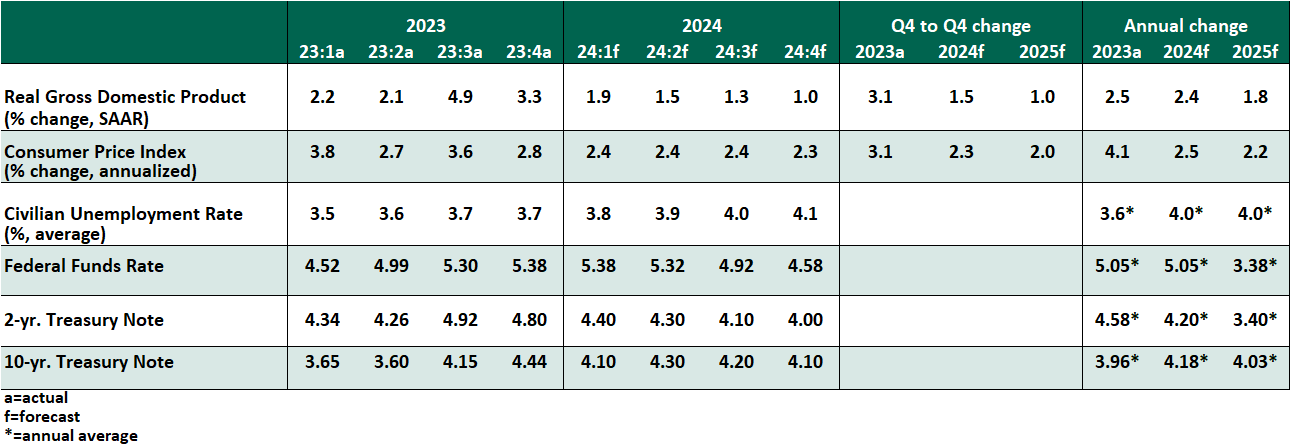- Who We Serve
- What We Do
- About Us
- Insights & Research
- Who We Serve
- What We Do
- About Us
- Insights & Research
Heavy Lifting
The Northern Trust Economics team shares its outlook for U.S. growth, employment, interest rates and inflation.
The year 2024 is off to a busy start, and not just in terms of economic data. Recent readings show continued growth in employment, income and spending. We are all working hard. The much-anticipated economic slowdown has yet to manifest.
The jobs report for January anchors a heady start to the year, continuing a year-long pattern of upside surprises in the data. Some cooling is needed to continue disinflation, and slower data is likely on the way. Central bank policy will remain tight for several more months before eventually easing.
We try to place incoming information into proper perspective. We’re not overly excited about recent positive surprises, nor will we be overly dark when we inevitably encounter negative ones. On balance, the year is off to a very solid start.
KEY ECONOMIC INDICATORS

Influences on the Forecast
- Gross domestic product (GDP) grew at an annualized rate of 3.3% in the fourth quarter. Growth for the full year (on a Q4/Q4 basis) was 3.1% in 2023—overcoming a year of high interest rates, high inflation and high recession expectations. Annualized consumer spending growth of 2.8% once again led the overall increase. The momentum coming into the new year has prompted us to revise our projections upward. Outsized gains will not be the norm, but a forecast of below-potential growth is hard to justify.
- The January employment report showed a remarkable addition of 353,000 jobs, with most sectors showing gains. The prior two months were revised upward, breaking a streak of downward revisions. The unemployment rate held steady at 3.7%. Average hourly earnings grew 0.6% on the month, or 4.5% year over year, led by services sectors; the inflationary risk of service prices remains a concern
- Other indicators show a normalizing labor market through the end of 2023. The rates of quitting (2.2%) and hiring (3.6%) have returned to their pre-pandemic norms, while involuntary separations have yet to materially increase. The Employment Cost Index (ECI), which reflects total compensation including benefits, grew only 0.9% from the third to the fourth quarter, its slowest rate since 2021. - Inflation continues to heal, but unevenly. Headline measures have been flattered by stable prices of energy and food, as seen in personal consumption expenditures inflation of 2.6% year over year in December. Goods prices have held a near-flat price level since mid-2022, but service costs continue to appreciate. A more balanced disinflationary trend will be needed to bring about looser monetary policy.
- The January meeting of the Federal Open Market Committee (FOMC) brought no change to interest rates or asset reductions. However, the FOMC statement was revised to state the committee will not cut rates “until it has gained greater confidence that inflation is moving sustainably toward 2 percent.” In the subsequent press conference, Chair Powell more explicitly stated that a cut in March was “not the most likely case.” Rate cuts are still in store later this year. We expect a total of four 25 basis point reductions, beginning in June.
- Powell also mentioned that the March FOMC meeting agenda will include discussion of the Fed’s balance sheet strategy. The Fed’s securities portfolio has declined by $1.4 trillion from its May 2022 peak. Surplus liquidity placed in the overnight reverse repurchase facility has fallen by 80% from its maximum, as more money funds are purchasing Treasuries. More balance sheet clarity from the Fed will help to prevent an overnight funding shock. - The Federal Reserve’s quarterly Senior Loan Officer Opinion Survey (SLOOS) showed an inflection of fewer banks tightening their loan standards for business and commercial real estate (CRE) loans. The SLOOS was an indicator of tight credit conditions in the wake of last year’s bank failures and may foretell more lending activity ahead. However, demand for these loans is still diminished.
- Earnings among publicly-traded regional banks for the fourth quarter of 2023 reignited some fears of strains from CRE exposure. The challenge of these underperforming loans is not new. Given their terms of up to ten years, they will present an ongoing challenge as they are renegotiated in the years ahead. Fortunately, outside of office spaces in central business districts, most other CRE asset classes are performing adequately.
Related Articles
Meet Our Team

Carl R. Tannenbaum
Chief Economist

Ryan James Boyle
Chief U.S. Economist

Vaibhav Tandon
Chief International Economist
Subscribe to Publications on Economic Trends & Insights
Gain insight into economic developments and our latest forecasts for the United States.
Information is not intended to be and should not be construed as an offer, solicitation or recommendation with respect to any transaction and should not be treated as legal advice, investment advice or tax advice. Under no circumstances should you rely upon this information as a substitute for obtaining specific legal or tax advice from your own professional legal or tax advisors. Information is subject to change based on market or other conditions and is not intended to influence your investment decisions.
© 2025 Northern Trust Corporation. Head Office: 50 South La Salle Street, Chicago, Illinois 60603 U.S.A. Incorporated with limited liability in the U.S. Products and services provided by subsidiaries of Northern Trust Corporation may vary in different markets and are offered in accordance with local regulation. For legal and regulatory information about individual market offices, visit northerntrust.com/terms-and-conditions.